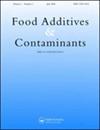山东水产品中的多氯联苯。
IF 2.5
3区 农林科学
Q2 CHEMISTRY, APPLIED
Food additives & contaminants. Part B, Surveillance
Pub Date : 2025-06-01
Epub Date: 2025-01-14
DOI:10.1080/19393210.2025.2450802
引用次数: 0
摘要
在110个样本中分析了多氯联苯,包括海鱼、淡水鱼和海洋双壳类。海洋鱼类的∑7PCBs含量为0.18 ~ 5.59 ng g-1湿重(ww),淡水鱼为0.10 ~ 1.19 ng g-1 ww,海洋双壳类为0.07 ~ 5.59 ng g-1 ww。多氯联苯含量最高的是鼠尾螺。在海鱼、淡水鱼和海洋双壳类中,含量最高的化合物分别是Hexa-CBs、Tri-CBs和Hexa-CBs。多氯联苯在水产品中以特定物种的方式分布。分析的水产品样本均未超过中国规定的∑7pcb限量或欧盟规定的限量。本文章由计算机程序翻译,如有差异,请以英文原文为准。
Polychlorinated biphenyls in aquatic products from Shandong, China.
PCBs were analysed in 110 samples, including marine fish, freshwater fish and marine bivalves. The levels of ∑7PCBs in marine fish ranged from 0.18 to 5.59 ng g-1 wet weight (ww), in freshwater fish from 0.10 to 1.19 ng g-1 ww and in marine bivalves from 0.07 to 5.59 ng g-1 ww. The highest level of PCBs was found in Scomberomorus niphonius. In marine fish, freshwater fish and marine bivalves, the most abundant compounds were Hexa-CBs, Tri-CBs and Hexa-CBs, respectively. PCBs were distributed in a species-specific manner in aquatic products. None of the aquatic product samples analysed exceeded the limit for ∑7PCBs set by China or the limit established by the European Union.
求助全文
通过发布文献求助,成功后即可免费获取论文全文。
去求助
来源期刊
CiteScore
5.30
自引率
10.30%
发文量
37
审稿时长
2.7 months
期刊介绍:
Food Additives & Contaminants: Part B publishes surveillance data indicating the presence and levels of occurrence of designated food additives, residues and contaminants in foods, food supplements and animal feed. Data using validated methods must meet stipulated quality standards to be acceptable and must be presented in a prescribed format for subsequent data-handling.
Food Additives & Contaminants: Part B restricts its scope to include certain classes of food additives, residues and contaminants. This is based on a goal of covering those areas where there is a need to record surveillance data for the purposes of exposure and risk assessment.
The scope is initially restricted to:
Additives - food colours, artificial sweeteners, and preservatives;
Residues – veterinary drug and pesticide residues;
Contaminants – metals, mycotoxins, phycotoxins, plant toxins, nitrate/nitrite, PCDDs/PCFDs, PCBs, PAHs, acrylamide, 3-MPCD and contaminants derived from food packaging.
Readership: The readership includes scientists involved in all aspects of food safety and quality and particularly those involved in monitoring human exposure to chemicals from the diet.
Papers reporting surveillance data in areas other than the above should be submitted to Part A . The scope of Part B will be expanded from time-to-time to ensure inclusion of new areas of concern.

 求助内容:
求助内容: 应助结果提醒方式:
应助结果提醒方式:


